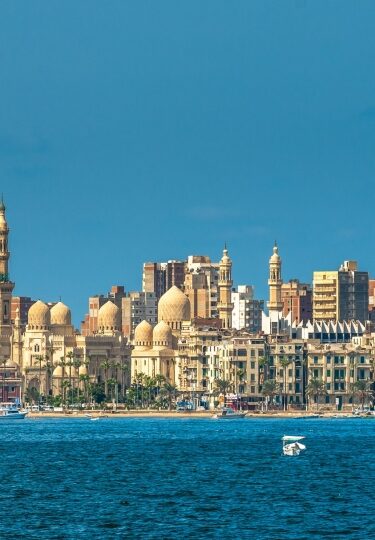Alexandria sits near the mouth of the River Nile on the shores of the Mediterranean. It is a city with more than 2,000 years of history, once Egypt’s capital and still the largest city in the Mediterranean region.
A modern metropolis of nearly four million people, Alexandria has an extensive tram network that was the first in Africa. But its heart remains the area alongside the seafront Corniche from Qaitbay Citadel to the Montazah Palace that’s packed with reminders of its historic past.
If you can fit them in between people-watching on its busy streets or sampling cakes in a neighborhood bakery, here are some of the best things to do in Alexandria, Egypt.
1: Find Inspiration in the Bibliotheca Alexandrina
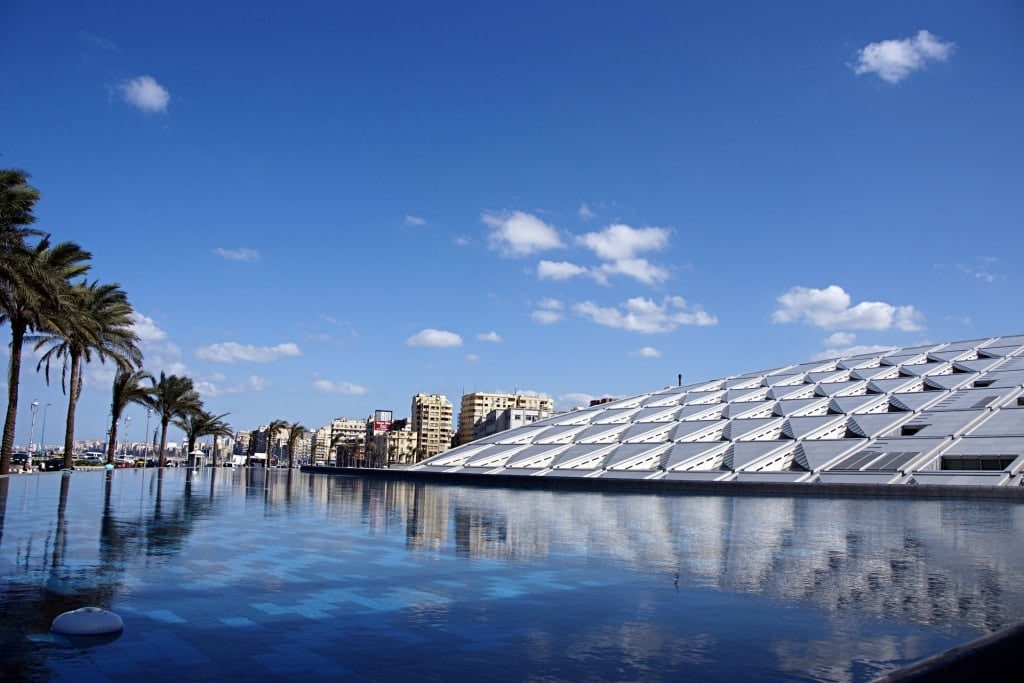
Bibliotheca Alexandrina
The ancient Library of Alexandria, founded around 300 BCE, is said to have held all the knowledge in the world at the time. Archimedes invented his famous Water Screw while studying there and Eratosthenes became the first scientist to calculate the circumference of the earth.
How amazed would those famous thinkers be by the knowledge we can all access through the internet? It’s an inspiring thought and one firmly grasped by this modern reincarnation with its vision to unite all nations by sharing knowledge digitally.
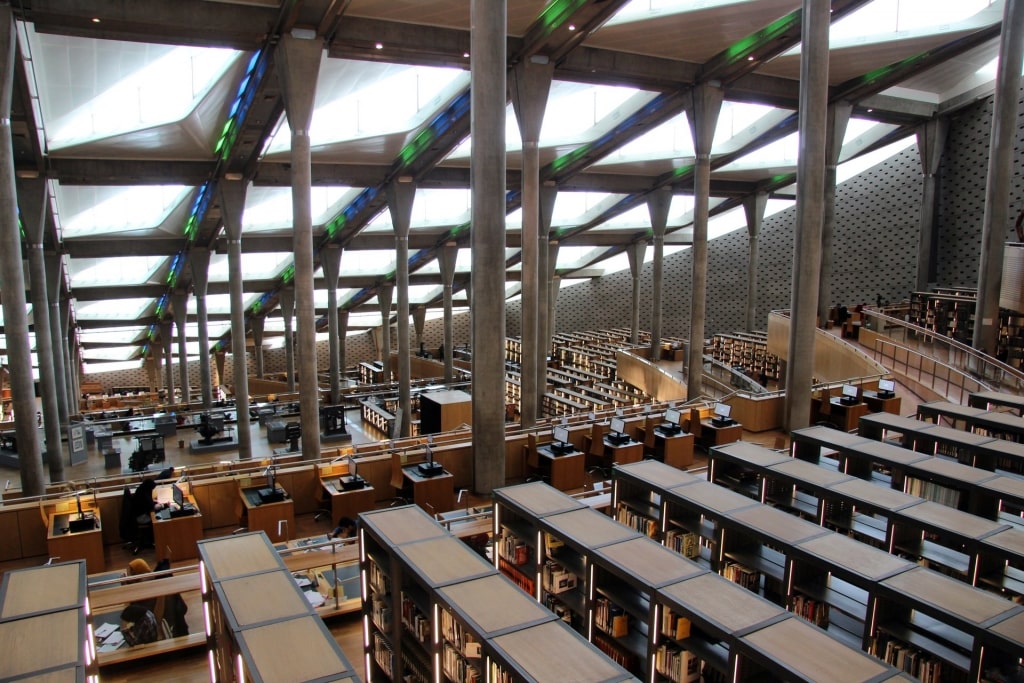
Bibliotheca Alexandrina
This digital concept includes being the first home for an external backup of the Internet Archive. However, Bibliotheca Alexandrina’s shelves also have room for eight million books in Arabic, English and French, with France donating 500,000 alone.
As well as a library, the striking building has exhibition spaces, museums, art galleries and a planetarium. A worthy successor to the historic original, it’s a must-see and one of the most important things to do in Alexandria, Egypt.
2: Admire the Citadel of Qaitbay
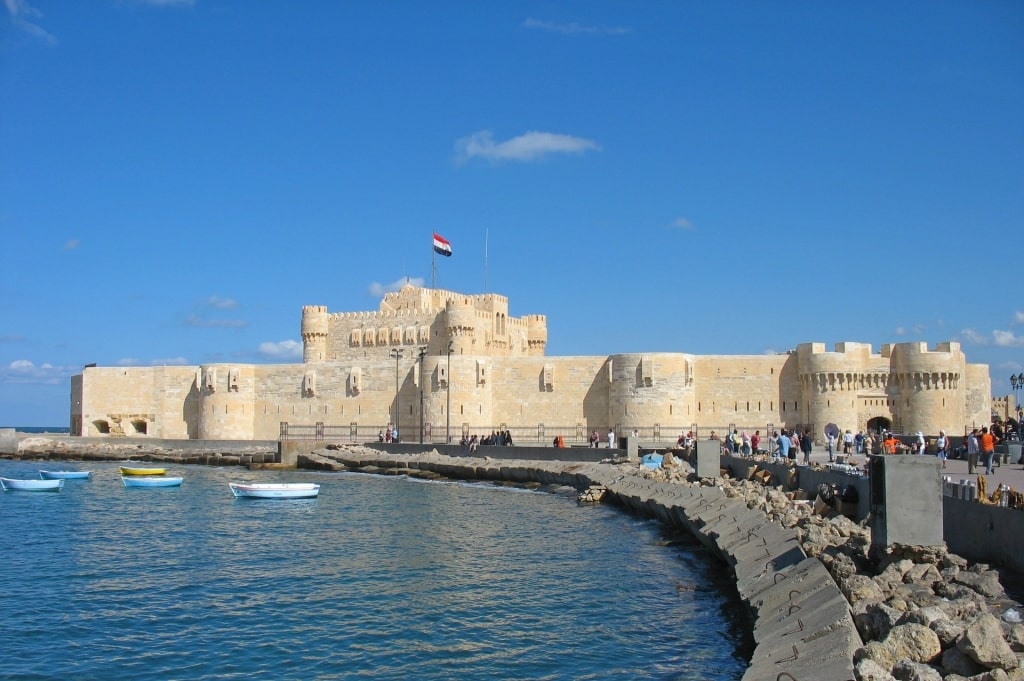
Citadel of Qaitbay
Sitting on the site of the Pharos Lighthouse—one of the Seven Wonders of the Ancient World—and built with some of its massive stones, Fort Qaitbay dominates the seafront of Alexandria.
The lighthouse, which dated to the third century BCE, was destroyed by a series of earthquakes between 900 and 1323 AD. This fortress was constructed on its remaining base in 1477 to protect against invasion by the Ottoman Empire.
It has been restored over the centuries, most notably following its partial destruction during the bombardment of Alexandria in 1882, when the British wrested control of the Suez Canal from Egypt.

Corniche
Collect a cooling treat from one of the city’s popular ice cream parlors and enjoy the walk along the Corniche with the citadel as a destination. Then you can enjoy the great views of the Mediterranean and the rest of the city itself from the imposing ramparts.
3: Delve Into the Alexandria National Museum
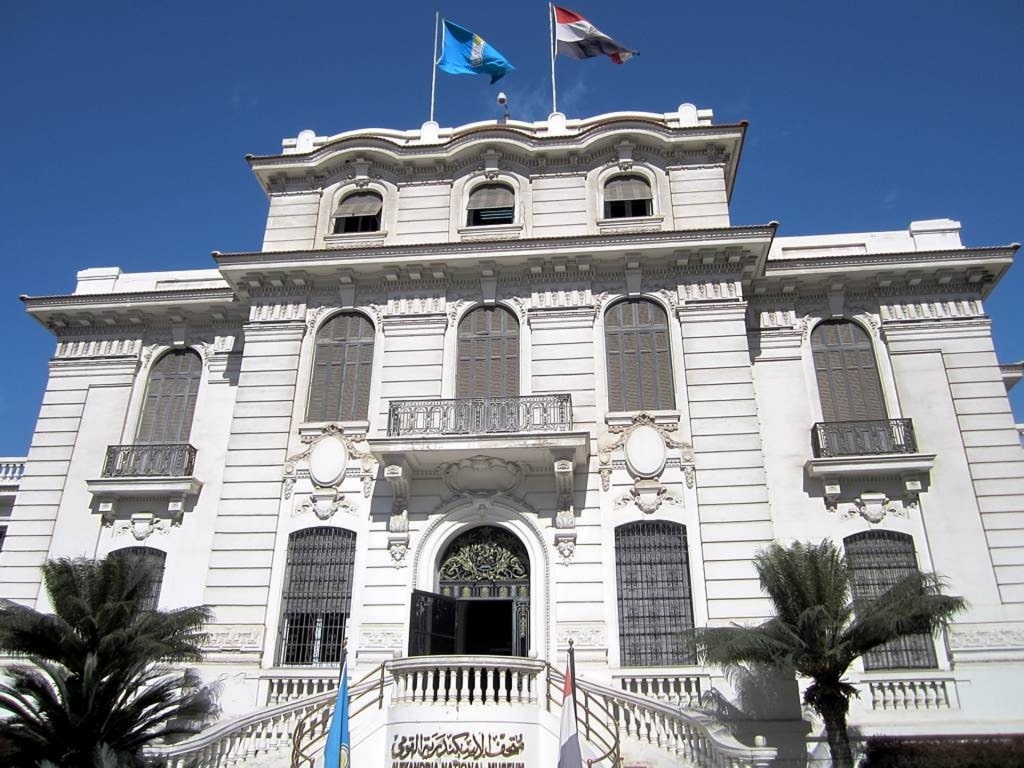
Alexandria National Museum Photo by David Stanley on Flickr, licensed under CC BY 2.0
To understand Alexandria, there’s nowhere better to start than the Alexandria National Museum. Set in a handsome Italianate palace, once home to a wealthy wood merchant and later the American Consulate, this museum holds treasures from thousands of years of history.
Its three floors take you on a journey through time as you go from the Pharaonic era with its mummies in the basement through to the Graeco-Roman eras on the ground floor. The top floor covers Coptic Christian and Islamic history, ending with artifacts from the reign of the Egyptian Royal Family that ended in 1952.
Highlights include a replica of a tomb from the Valley of the Kings, Hatshepsut, a head of the female pharaoh, Hatshepsut, Coptic icons of Jesus and Mary, and Graeco-Roman mosaics. This is also the place to see some remarkable underwater discoveries from Cleopatra’s Palace.
4: Stroll the Montazah Palace Gardens
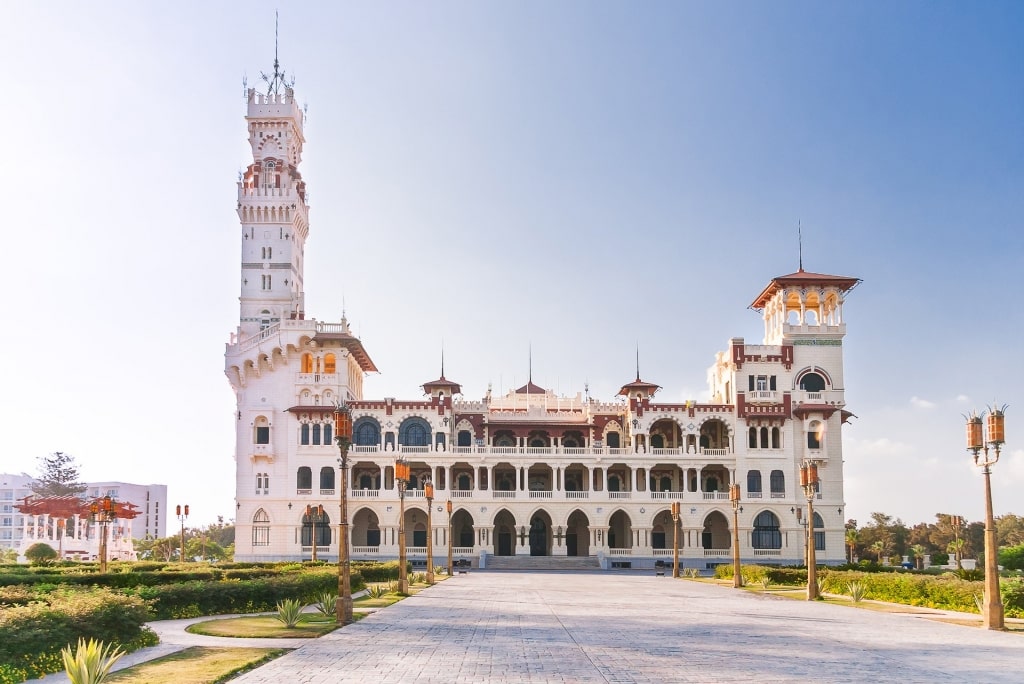
Montazah Palace Gardens
The Montazah (“Garden”) Palace was built in the early 20th century in a wonderful mix of Ottoman and Byzantine architecture. The former summer home of the Egyptian Royal Family, its extensive grounds were originally laid out for hunting.
These gardens, now open to the public, are a popular spot for picnics and sunset walks, with the many mature trees giving welcome shade from the Mediterranean sun. Rare tropical plants and spreading date palms add an exotic touch to the formal layout.
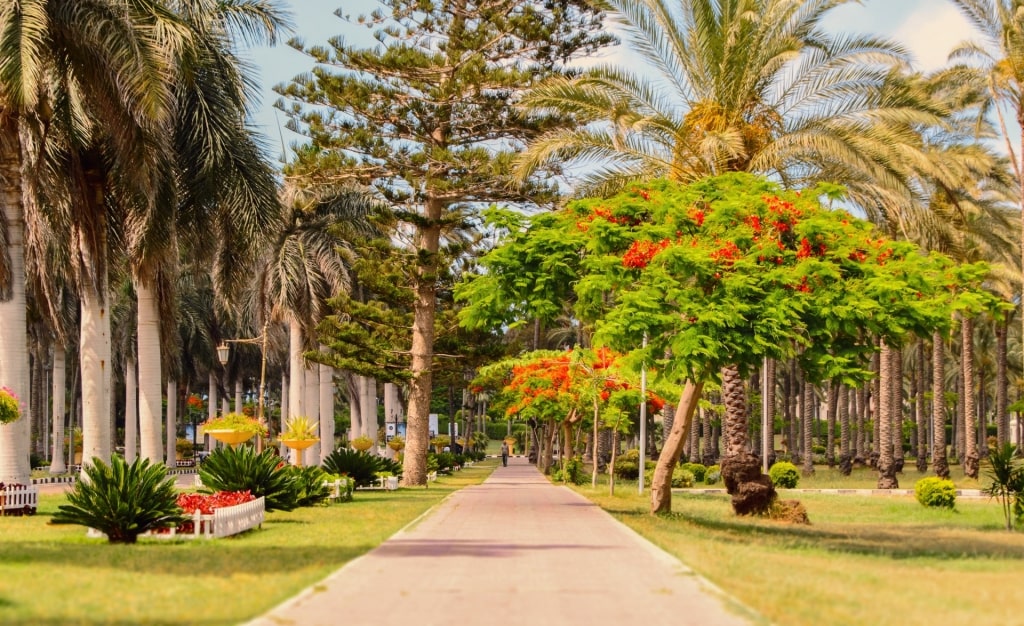
Montazah Palace Gardens
The palace site was chosen for its sea views and overlooks a number of beaches, as well as taking in a small island linked by a quaint bridge. A tea house named for King Farouk was opened in 2020 to add to the appeal.
5: Shop in the Souks
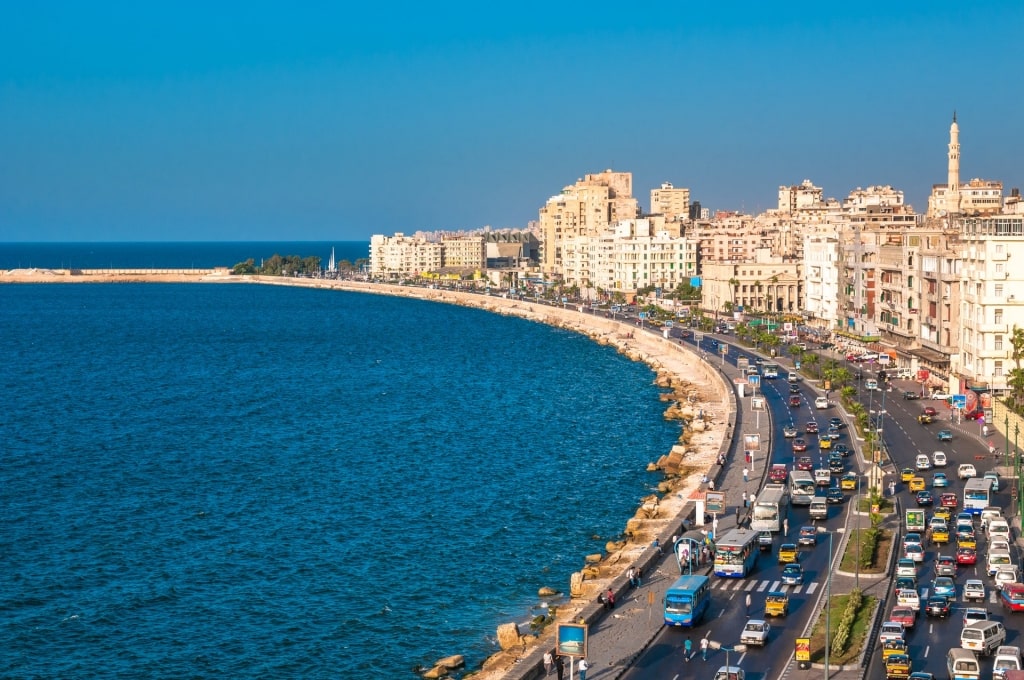
Corniche
Like any port city, Alexandria has a rich trading past that continues to this day in its multitude of shops, department stores and markets. The Corniche is a handsome waterfront promenade from which you can plunge into side streets in search of the antiques and curios for which the city is famous.
Souk El-Attarine is a maze of shops selling everything from colorful spices to dusty clocks. It’s named for the perfume and spice shops that once dominated this labyrinth but today, you can also buy paintings, furniture and other finds that recall the city’s Belle Epoque era of Greek and Italian residents.

Corniche
Many shops sell Egyptian souvenirs such as costumes and clothing, hookah (nargilah) pipes or blown glassware. Having your name painted on papyrus paper is a must-do for any first-time visitor.
Haggle to your heart’s content but be aware that the sellers here have millennia of experience on their side. To Egyptians, haggling over a sale is a pleasurable social interaction, so enjoy the challenge!
6: Gaze at the Great Pyramids of Giza
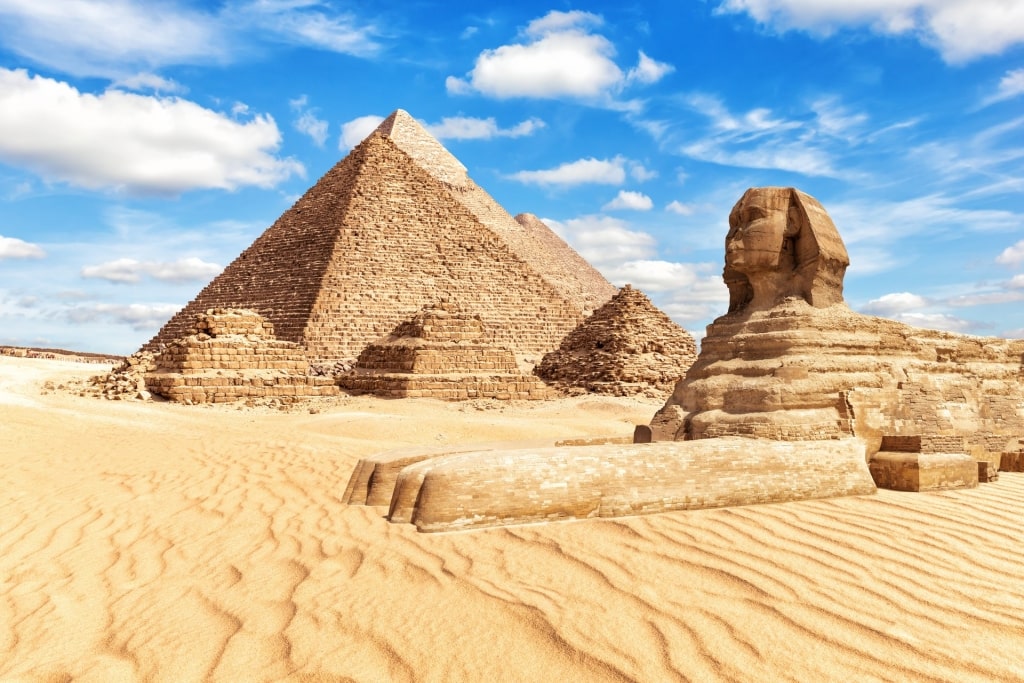
Great Pyramids of Giza
These famous wonders are only a few hours’ drive away from Alexandria and offer a chance to experience much more of the sights and sounds of Egypt. An overnight stay in Cairo is an excellent option if you do not want to return the same day.
It’s amazing to think these awesome monuments are 4,500 years old. When the ill-fated lovers Cleopatra and Caesar sailed down the Nile to Giza in around 48 BCE, the pyramids would already have been standing for an astonishing 2,500 years.
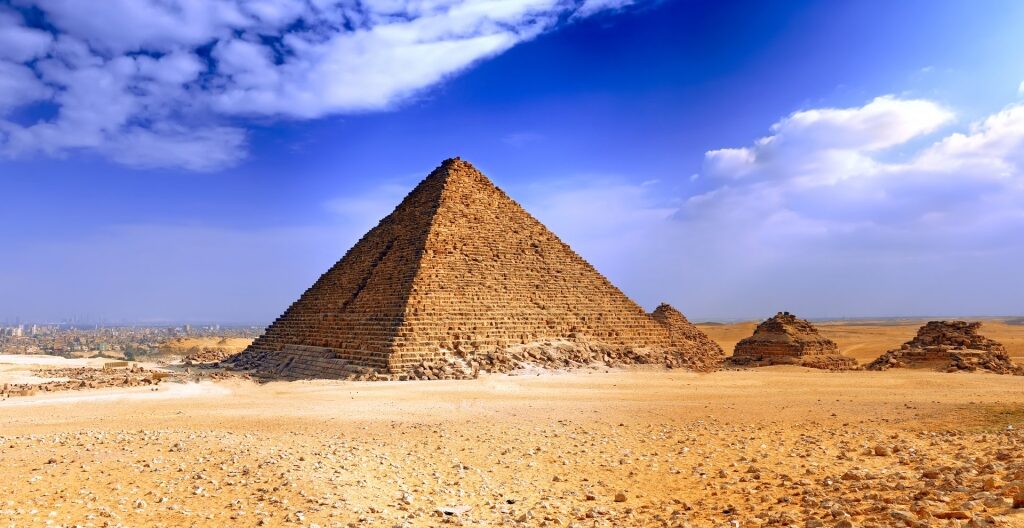
Great Pyramid of Pharaoh Khufu
The largest, the Great Pyramid of Pharaoh Khufu, is 481 feet high and made of blocks weighing up to 15 tons. Despite centuries of speculation, no one knows for sure how it was built.
However, while it is structures such as the pyramids and Great Sphinx that will draw you to this vast complex, it is the detail that may stay with you. Carvings and wall paintings reach across time to give you a vivid picture of daily life in those ancient times.
7: Descend Into the Catacombs of Kom el Shoqafa
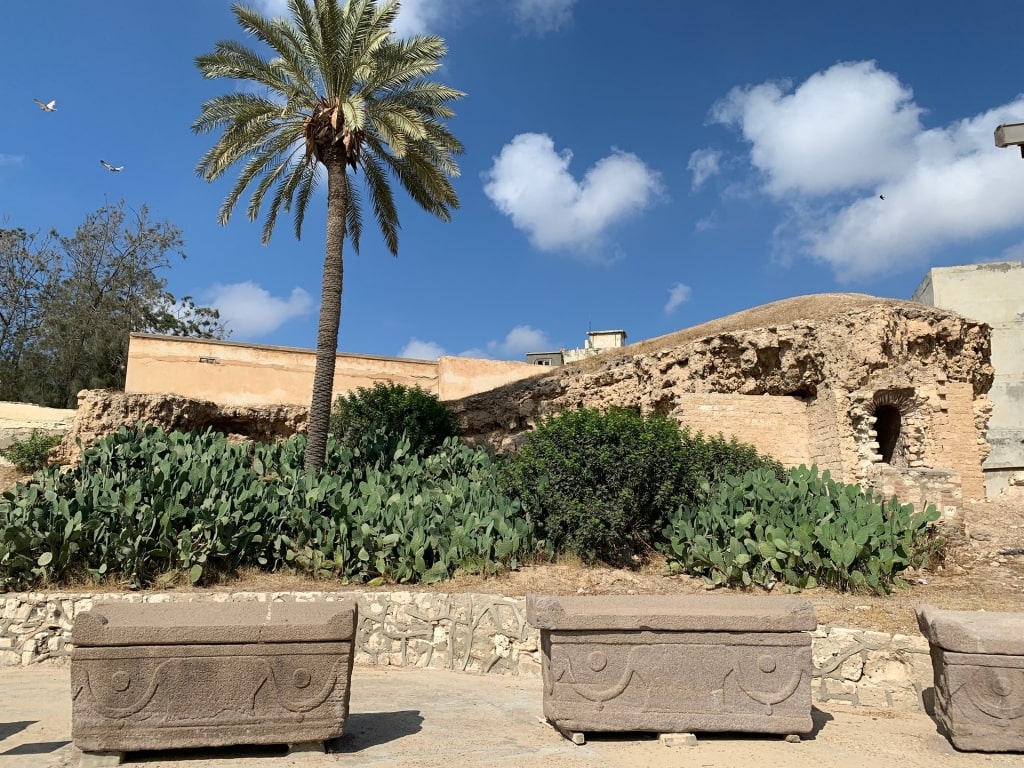
Catacombs of Kom el Shoqafa
Used to bury the dead for 200 years from the second century onwards, these catacombs reflect a time where Alexandria was undergoing profound change.
In 332 BCE, Macedonia’s Alexander the Great conquered Egypt and founded Alexandria, with his trusted general Ptolemy becoming ruler after Alexander’s death. This Greek-speaking Ptolemaic Empire, adopting the title and style of the pharaohs, lasted 300 years, until Cleopatra, its queen and last ruler, was in turn defeated by the Romans in 30 BCE.
Deep in the tunnels and chambers of this vast complex, you will find a combination of all three of these ancient Egyptian, Hellenic and Roman influences. Such a mix of cultures in one place make these catacombs unique.
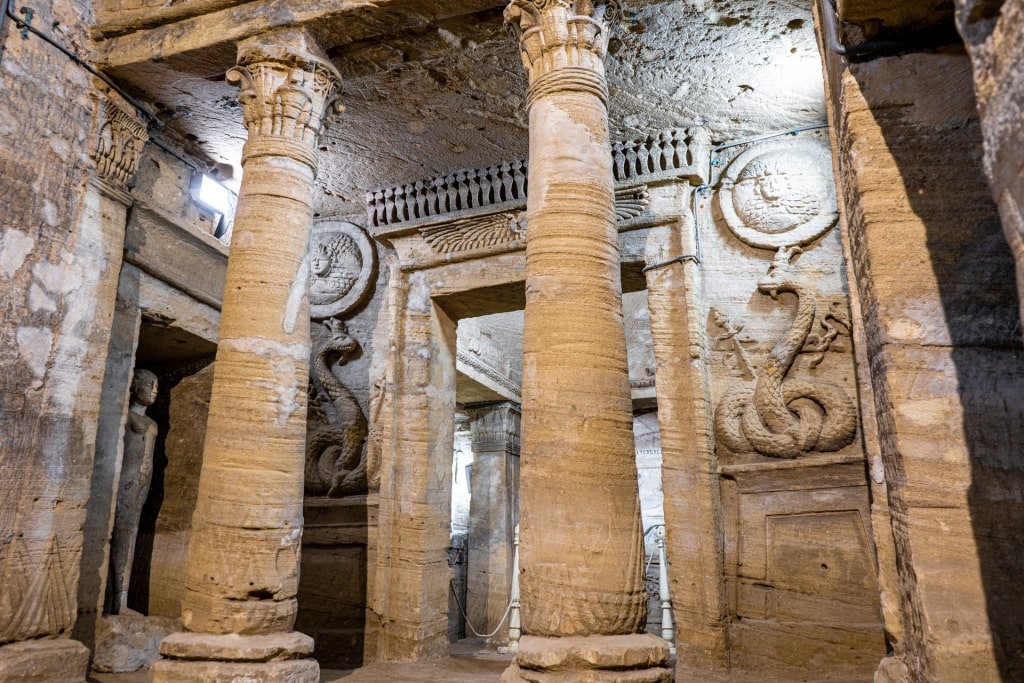
Catacombs of Kom el Shoqafa
You will see statues in poses familiar from Egyptian art but with Roman hairstyles, and carvings of serpents from Greek mythology but wearing the traditional Egyptian double crown.
Discovered in 1900, the catacombs took archaeologists 40 years to catalog. They are spread over three floors, although the deepest level is so far closed to visitors.
8: Take a Seat in the Ancient Roman Theater
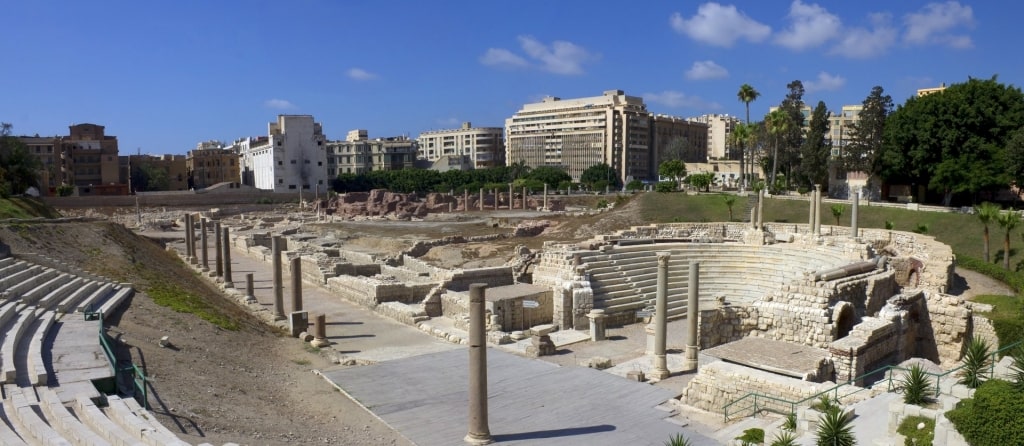
Ancient Roman Theater
The Roman Theater, in the heart of the city, is a centerpiece of the Kom el-Dikka site that also includes mosaic-rich Roman villas, baths and a cistern. Like the theater, many of these finds are unique in Egypt.
The theater dates originally to the fourth century AD and stands near a series of 22 auditoria identified as lecture halls for an estimated student population of 600. This is the first known educational complex from the ancient world, a reminder of Alexandria’s importance as a center of learning.
In this context, it’s likely the theater served as a grand hall or odeon for major speakers or lecturers. Its 13 remaining rows of marble seats bear graffiti from supporters of rival chariot teams, so perhaps some of those orators were not as riveting as history tells us.
9: Stroll By Stanley Bridge
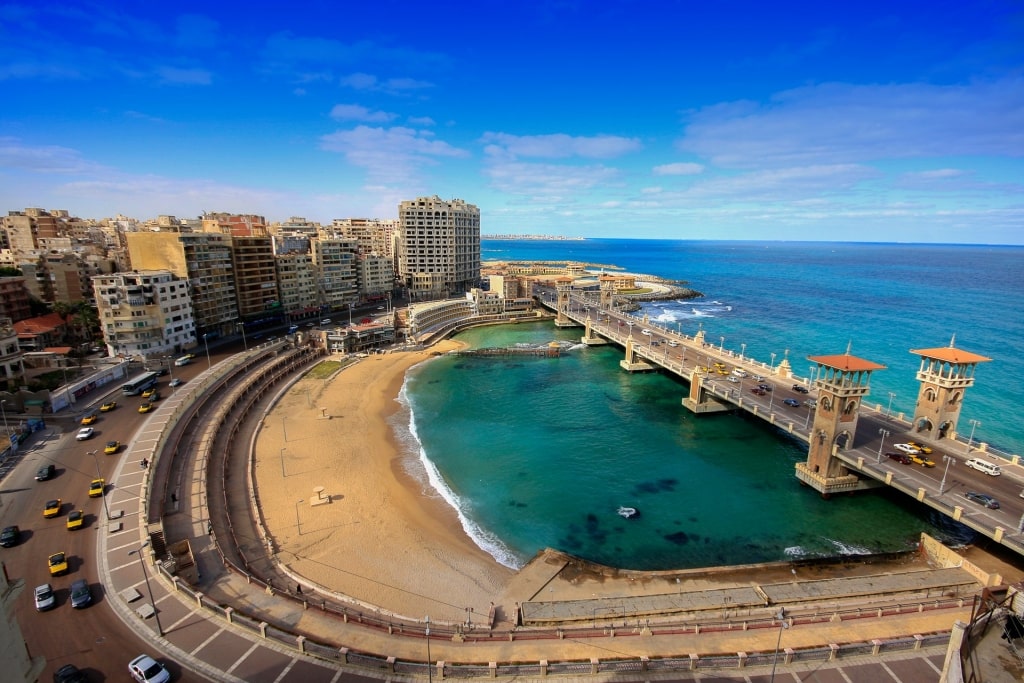
Stanley Bridge
The four towers on this handsome bridge echo the architecture of the Montazah Palace. As a key part of improvements to the Corniche, it was built over a small bay to straighten traffic flow along the seafront.
By helping to preserve the small beach in its shadow—perhaps the best in Alexandria—the bridge instantly won a firm place in the city’s affections. It also soon became known as “Lovers’ Bridge” for the couples using it to enjoy romantic Mediterranean sunsets and its lights twinkling on the water.
Like any Mediterranean city, the evening “passeggiata”, or stroll, is a ritual here to enjoy the cooler air after hot days. As the city shakes off the daytime sleepiness, nearby restaurants and cafés come alive catering for those who have walked up an appetite or just want to enjoy the view.
10: Be Dazzled at the Royal Jewelry Museum
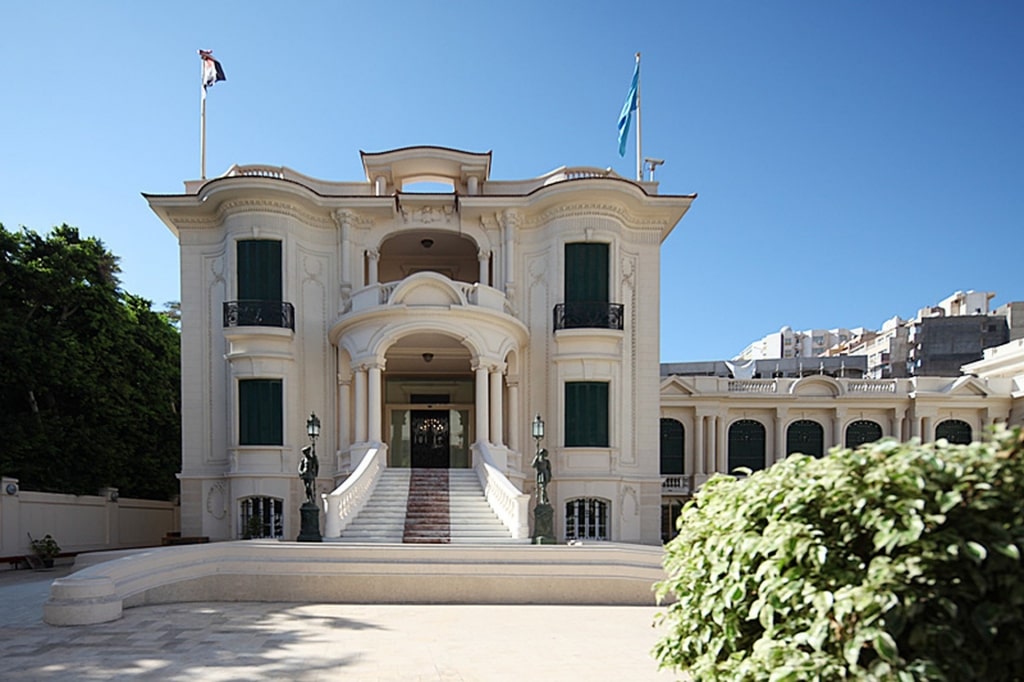
Royal Jewelry Museum Photo by Roland Unger on Wikimedia Commons, licensed under CC BY-SA 3.0
While the name tells you what to expect in this treasure trove of a museum, nothing can prepare you for the glorious collection on display. Once a villa for the Egyptian royal family, it is filled not only with priceless jewels but also clocks, watches, ornate chess sets and thousands of Roman, Byzantine, Persian and Coptic coins.
The building alone is worth the visit, with magnificent ceilings and stained glass windows. Look out for the beautiful tilework in the bathrooms and admire the paintings on every wall and ceiling.
11: Ponder Over Pompey’s Pillar
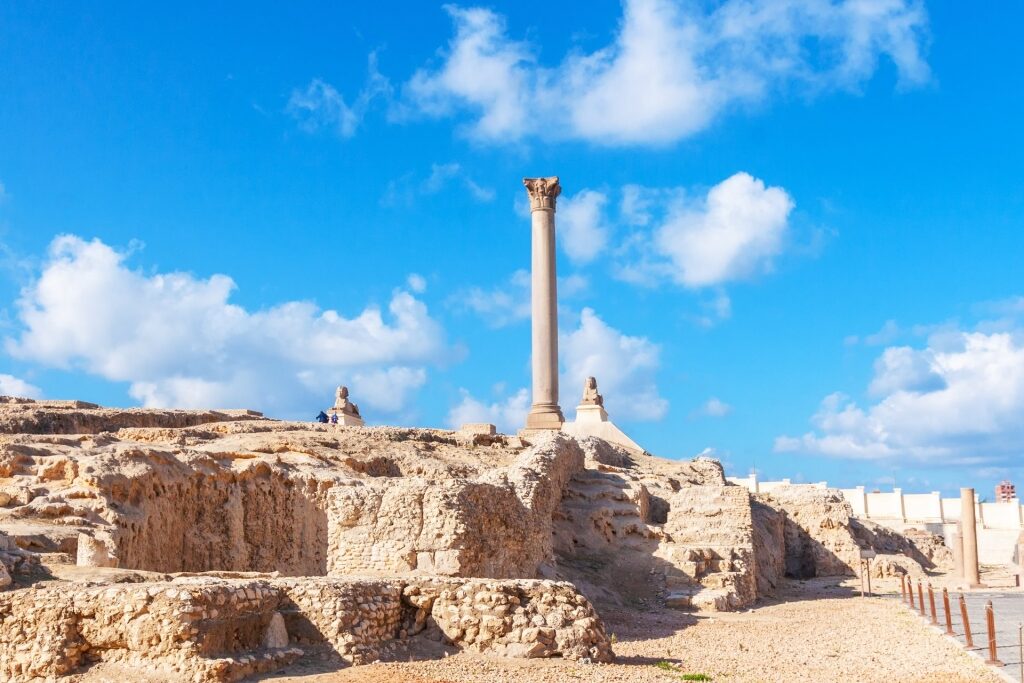
Serapeum and Pompey’s Pillar
The Serapeum was a temple that stood in this oldest part of Alexandria for about 500 years from around 220 BCE. Built by the Ptolemaic rulers, it was dedicated to Serapis, a god that conveniently combined their Greek beliefs and those of their Egyptian subjects.
The temple was destroyed after the rise of Christianity and little remains above ground. The underground galleries that survive were once thought to be part of the Library of Alexandria but were more likely used for the burial of sacred animals.
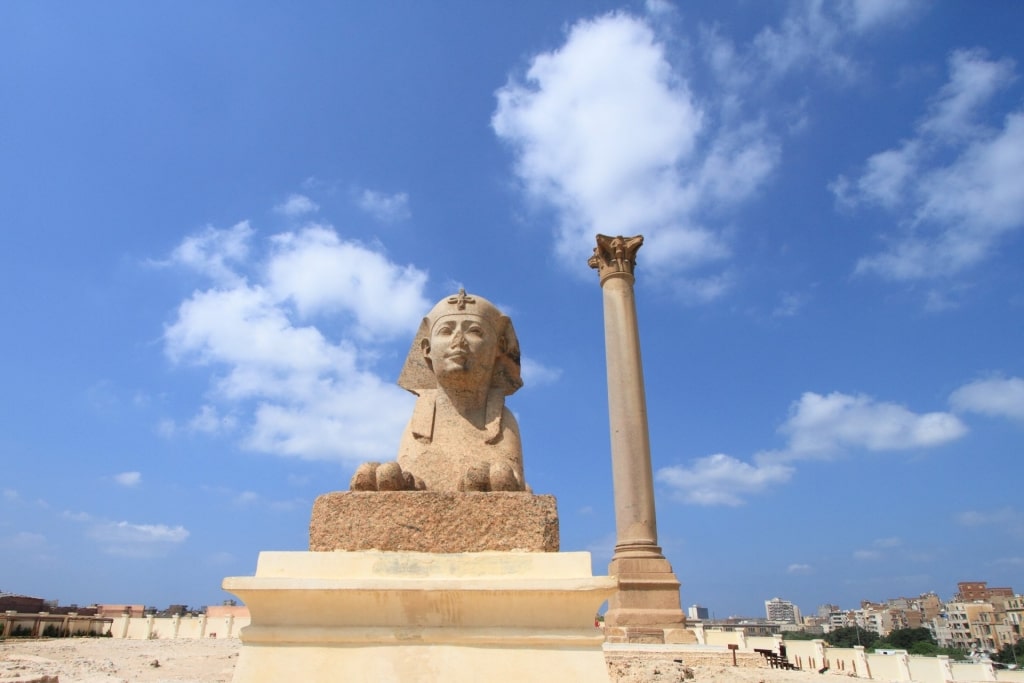
Pompey’s Pillar
The most memorable sight here is Pompey’s Pillar, a stone column standing 88ft high. It’s one of the largest monoliths in the world, weighing almost 300 tons and cut from pink granite that comes from Aswan, in Upper Egypt, hundreds of miles to the south.
Its name is a mistranslation of an inscription. The pillar is not dedicated to the Roman general Pompey, as originally thought. It was actually erected around 300 AD in honor of the Roman emperor Diocletian, whose statue, mounted on horseback, stood on top of the pillar. The whole monument commemorated Diocletian’s inauguration of a state grain supply.
12: Marvel at Al-Mursi Abu Al-Abbas Mosque
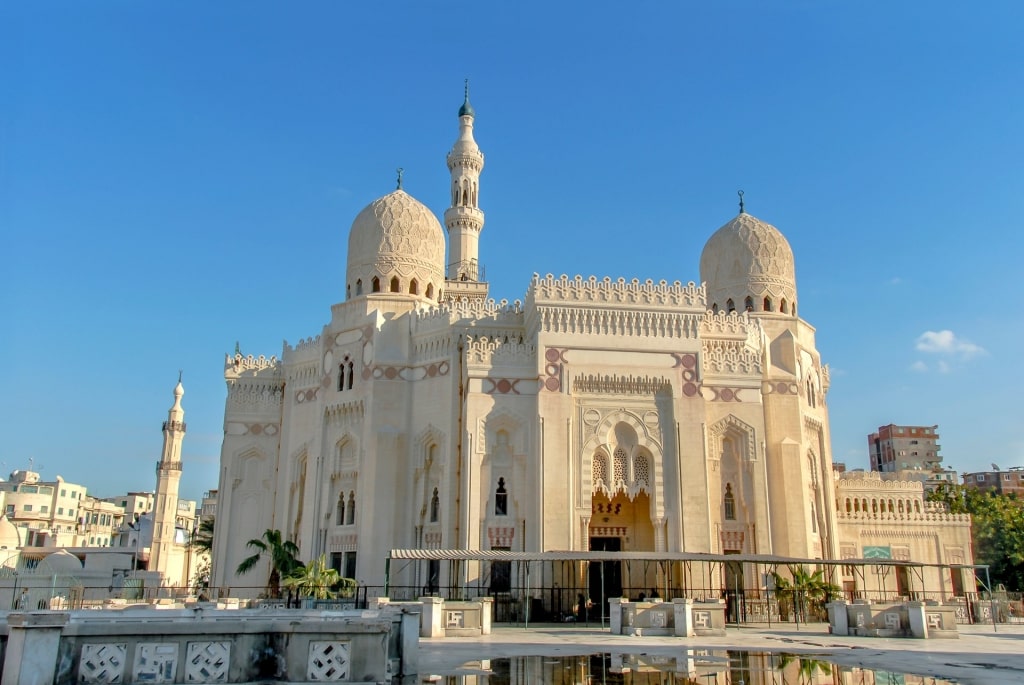
Al-Mursi Abu Al-Abbas Mosque
With a minaret soaring to 240 feet, this magnificent mosque is a major landmark on the Alexandria seafront. Both exterior and interior are highly decorated and the beautiful prayer hall holds 16 massive columns imported from Italy.
Born in 1219 in Murcia, Spain, Abu al-Abbas al-Mursi reached North Africa in 1242 after a shipwreck on a family pilgrimage to Mecca. He settled in Alexandria, winning fame as a scholar of Sufism, the mystical form of Islam best known through the poetry of his contemporary Rumi.
Following Abu Al-Abbas’s death in 1286, his mausoleum became a place of pilgrimage for North African Muslims. Over the centuries, a series of ever-grander mosques was built over the tomb, with this latest dating to 1946.
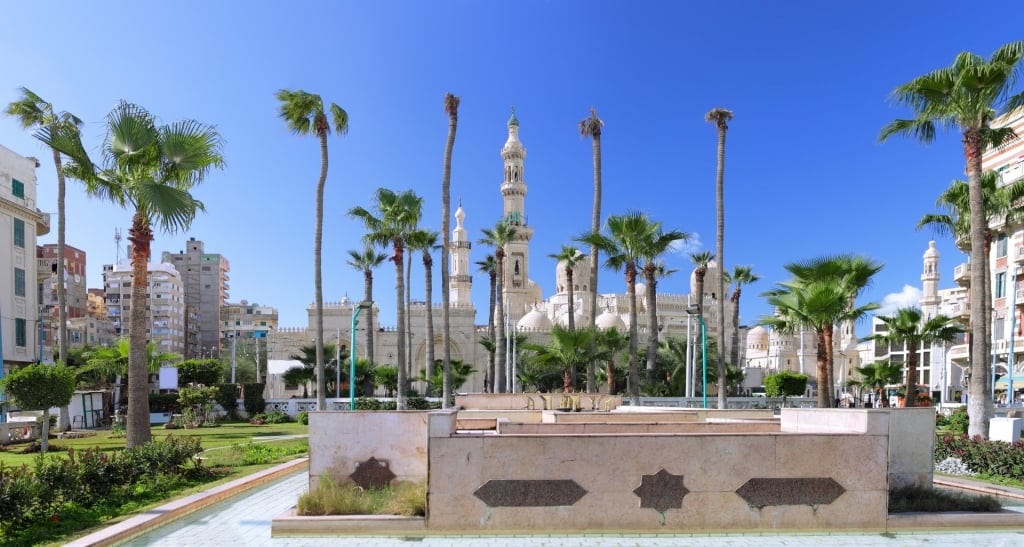
Al-Mursi Abu Al-Abbas Mosque
Italian architect Mario Rossi oversaw the planning and construction, which also included five other nearby mosques. The reinforced concrete framework and ornate mix of Andalusian and Persian styles he developed were revolutionary and have influenced contemporary mosques in cities from Washington DC to Abu Dhabi.
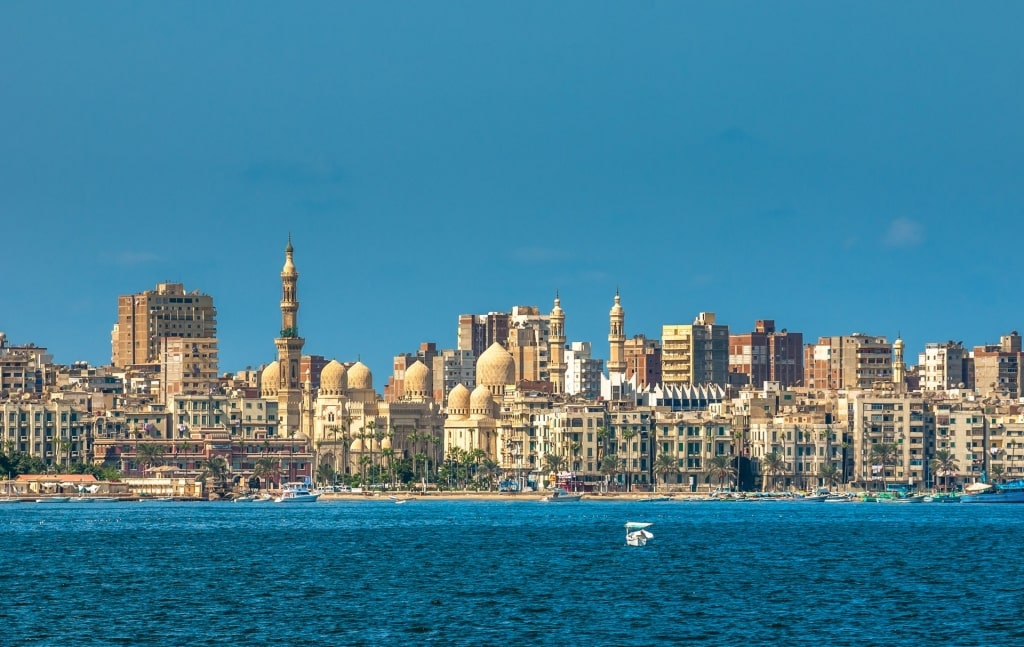
Alexandria
Is Alexandria, Egypt worth visiting?
While most visitors to Egypt head straight for the wonders of Giza and Luxor, you really should make time for Alexandria. This city, founded by Alexander the Great, where Euclid studied, and both Cleopatra and Napoleon met with defeat has a rich—and very different—history of its own.
Alexandria was ancient Rome’s most important commercial and cultural center in the Eastern Mediterranean. The city enjoyed something of a rival in the late 19th century, considered its “Belle Epoque”, and remains an important port today.
Earthquakes have leveled near-mythical buildings such as Cleopatra’s Palace and the Pharos Lighthouse, but the remaining sights, the extraordinary Library and superb museums are still enough to make Alexandria one of the world’s most overlooked great cities.
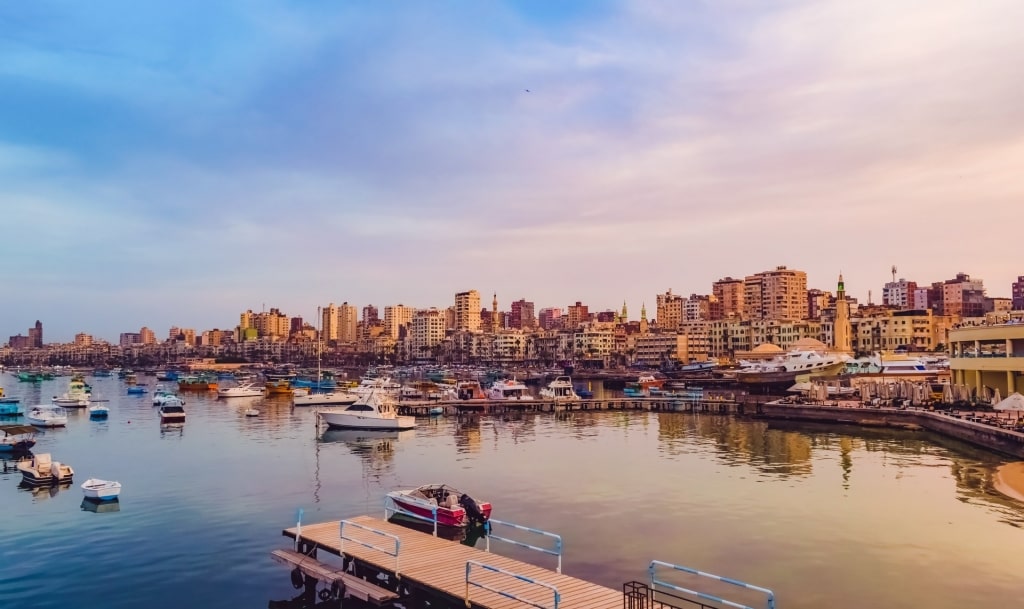
Alexandria
What is there to do in Alexandria, Egypt at night?
Alexandria has long been famous for its café culture and while its classic older establishments still thrive, they’ve been joined by a host of modern venues. A walk by the sea, followed by a coffee or meal with family or friends is an evening ritual here.
The city also has a number of pubs, bars and nightclubs. Many are in upmarket hotels, although traditional shisha bars remain a popular and lively option.
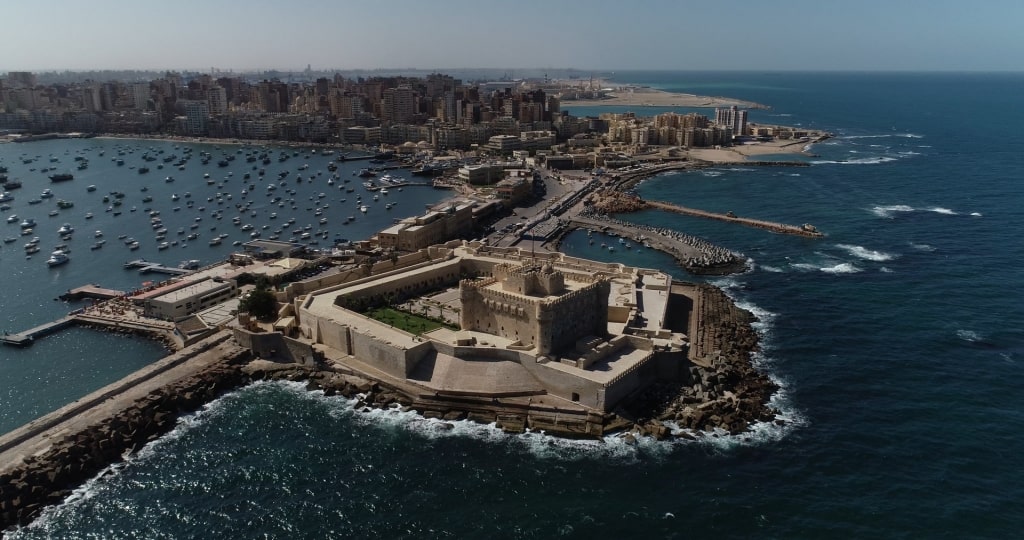
Alexandria
Inspired to explore the many things to do in Alexandria? Browse itineraries on our website and book your next cruise to Egypt and the Mediterranean.
